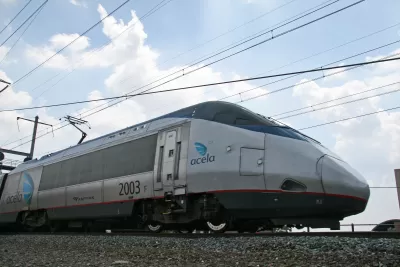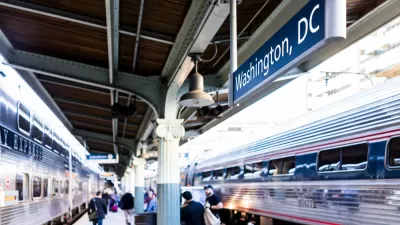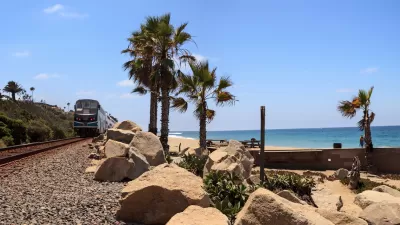New pilot projects authorized by the FAST Act include allowing private operators to bid on operating three of Amtrak's 15 long-distance lines for up to eight years "provided they reduce the need for taxpayer support" and allowing pets on trains.

Among the changes in the five-year Fixing America’s Surface Transportation (FAST) Act that was signed by President Obama on December 4 are these two Amtrak pilot projects. First, allowing private rail operators to bid on long distance routes (PDF) that some say will "likely will always lose money":
"(P)otential competitors would submit an operating plan that includes steps to reduce taxpayer operating subsidies by 10% or more, while at least matching Amtrak’s performance," writes Andrew Tangel for The Wall Street Journal. If they "took over some Amtrak routes, it would mark a significant shift in how America’s national passenger railroad has been run since the federal government created it in 1970."
Private operators have already penetrated the commuter rail sector. "Herzog Transit Services Inc. operates Caltrain in the San Francisco Bay area (and) Transdev North America Inc. [formerly Veolia Transportation] runs the Tri-Rail line in South Florida," notes Tangel.
For fiscal 2015, which ended Sept. 30, Amtrak said the Northeast Corridor generated $479 million in adjusted operating surpluses, while its long-distance lines lost $495 million. Its state-supported routes, which generally run under 750 miles, reported $96 million in operating losses.
“I’m not sure what kind of interest we’re going to get from private-sector partners in this,” said Robert Puentes, a senior fellow at the Brookings Institution.
Joseph Boardman, Amtrak’s president and chief executive, expressed doubts competitors would wind up taking over the lines. He noted the steep expenses associated with running long-distance trains, including staffing the dining cars, refueling and sewer and water service.
Another pilot project authorized by the FAST Act will strike close to home for pet lovers. They have Rep. Jeff Denham (R-Madera, Calif.), no friend of California high-speed rail, to thank, or more precisely, his 15 pound French bulldog, Lily, according to Jennifer Scholtes, transportation reporter for POLITICO Pro.
Amtrak will have to dedicate at least one “pet car” on each train, where feasible, to allow passengers to transport kenneled pets either as carry-on or checked luggage. The rail operator is barred from using any federal funds to operate the program and is instead required to charge an extra pet fee to cover the cost.
He and Lily have been trying since 2013 to make Amtrak pet-friendly.
"Little-heralded changes" in the FAST Act are the focus of a New York Times piece, including changes to the 1998 interstate tolling pilot project.
Hat tip: Mark Boshnack
FULL STORY: Amtrak Faces Prospect of Private Competition

Trump Administration Could Effectively End Housing Voucher Program
Federal officials are eyeing major cuts to the Section 8 program that helps millions of low-income households pay rent.

Planetizen Federal Action Tracker
A weekly monitor of how Trump’s orders and actions are impacting planners and planning in America.

Ken Jennings Launches Transit Web Series
The Jeopardy champ wants you to ride public transit.

New Jersey Lawsuit Targets Rent-Setting Algorithms
The state of New Jersey is taking legal action against landlords and companies that engage in what the state’s Attorney General alleges is illegal rent fixing.

Washington Legislature Passes Rent Increase Cap
A bill that caps rent increases at 7 percent plus inflation is headed to the governor’s desk.

From Planning to Action: How LA County Is Rethinking Climate Resilience
Chief Sustainability Officer Rita Kampalath outlines the County’s shift from planning to implementation in its climate resilience efforts, emphasizing cross-departmental coordination, updated recovery strategies, and the need for flexible funding.
Urban Design for Planners 1: Software Tools
This six-course series explores essential urban design concepts using open source software and equips planners with the tools they need to participate fully in the urban design process.
Planning for Universal Design
Learn the tools for implementing Universal Design in planning regulations.
Heyer Gruel & Associates PA
Ada County Highway District
Institute for Housing and Urban Development Studies (IHS)
City of Grandview
Harvard GSD Executive Education
Toledo-Lucas County Plan Commissions
Salt Lake City
NYU Wagner Graduate School of Public Service





























